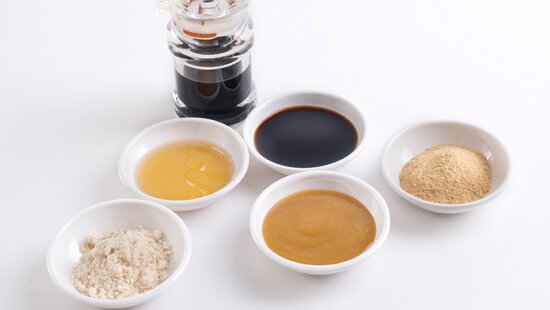Condiments and sauces come in a wide variety and they enhance flavour of foods when used properly. Even though taste may be enhanced by adding sodium and sugar containing condiments and sauces, excessive use will increase health risks. After examining 65 samples of commonly used seasonings, the Consumer Council found most of them rich in sodium, and some of those also contain a high content of sugars.
The Council also found that nutrition labels of 7 samples are inaccurate. These samples have been subsequently referred to the Centre for Food Safety (CFS) for follow up actions. Regulations in Hong Kong requires all pre-packaged food to display clear nutrition labelling unless otherwise exempted. Applying false description to the nutrition label or any advertising material will constitute an offence.
Sodium is a mineral commonly found in food in the form of sodium chloride (NaCl), commonly known as salt. While appropriate amount is essential for keeping good health and for the body to function, excessive consumption for an extended period of time may be hazardous to the vascular system and may increase the risk of coronary artery diseases. The World Health Organization (WHO) suggests a daily intake of no more than 2,000 milligrams of sodium for a healthy adult, which equals approximately 1 level teaspoon (5 grams) of salt. Condiments and sauces are the major contributors (44%) to the total sodium intake of the adult population in accordance with the CFS. Previous local studies indicated an average salt intake by an adult in Hong Kong was in the amount of 10 grams a day, 100% higher than the level recommended by the WHO.
The Council collected 65 samples of seasonings in 5 categories, namely chicken powder, chicken stock, fish powder, fish sauce and soy sauce. Nutrition labels on the packages were reviewed and the sodium and sugars levels were compared. The study concluded that chicken powder was found to be most sodium-rich in content, with 16,980 milligrams of sodium on average per 100 grams or millilitres. 1 sample contains as high as 21,600 milligrams of sodium per 100 grams. An intake of 9.3 grams of that sample will exceed the daily intake limit recommended by the WHO. The lowest content of sodium found in the samples is 12,378 milligram of sodium per 100 grams.
As for light soy sauce, which is commonly used in Chinese cuisine, the 19 samples were found to contain 6,200 to 8,390 milligrams of sodium per 100 millilitres. The average sodium content was 7,113 milligrams, which means every level teaspoon of light soy sauce constitutes 18% of the recommended daily intake of sodium. Although the sodium content seems to come in little portion, consumers may exceed the intake threshold by absorbing sodium from other foods, especially where soy sauce is put in the food while dining.
There is a perception that light soy sauce is more salty than dark soy sauce, but in fact dark soy sauce contains higher content of sodium on average. The 9 dark soy sauce samples contained 7,468 milligrams of sodium on average per 100 millilitres, 355 milligrams more than the light soy sauce samples. A probable reason is that dark soy source contains higher level of sugars and the sweet taste overshadows some of the salty taste. In fact, the dark soy sauce samples contain 15 grams of sugars on average per 100 millilitres, twice as much as that of light soy sauce. Apart from giving energy to human bodies, sugars carries no other nutritional value. On the other hand, excessive intake of sugars would lead to tooth decay and increase the risks of overweight and obesity.
The 10 samples of fish sauce, another commonly used seasoning, were found to contain 6,780 to 11,975 milligrams of sodium per 100 millilitres, but the sugars content was relatively lower. 4 of the samples were even found to be sugars free.
The hectic lifestyle may cause many locals to dine out for all 3 meals in a day. To put a low-sodium diet into practice, consumers should abstain from putting sauce of a dish in the rice they eat or drinking the soup base of noodles, as both contain high levels of sodium. A study from the CFS showed that a dish of cha siu (barbecued pork) rice contains 1,300 milligrams of sodium, which is two-folds of the recommended intake of sodium for each meal. A dietitian suggested that intake of sodium content could be reduced to 720 milligrams when taking the same dish without the sauce, keeping the intake at a more manageable level.
A healthy diet takes a long time to develop and it is difficult to stop using seasonings all in a sudden. Nevertheless, not only can consumers gradually reduce the use of seasonings, they can also replace seasonings with natural ingredients or herbs that are low in sodium content such as ginger, green onion, black pepper, thyme, and even sesame oil, vinegar and wine.
Consumers may consider following tips when choosing and applying seasonings.
- Read the information about sodium and sugars content on nutritional labels carefully. Some high-sodium content seasonings may not taste very salty because a good amount of sugars has been added.
- Use measuring spoon and measuring cup to gauge precisely the amount of seasonings used. Cut down the usage gradually for a healthier diet.
- Apart from seasonings, some foods may contain sodium and sugars, food additives is one of the source of sodium intake. Take this into account when counting the total amount of intake.
- To extend the marinating time so that less seasonings is required.
- Minimize eating of processed foods such as ham and sausages, and replace seasonings with natural ingredients and herbs with unique flavor.
The Consumer Council reserves all its right (including copyright) in respect of CHOICE magazine and Online CHOICE (https://echoice.consumer.org.hk/).



